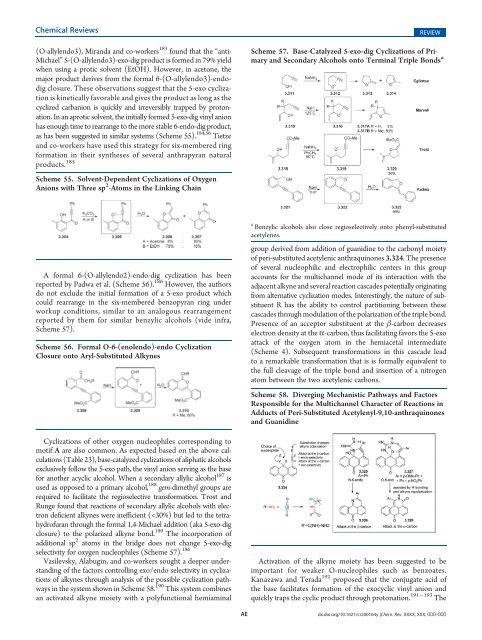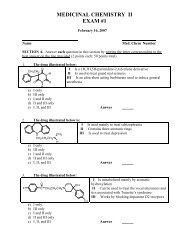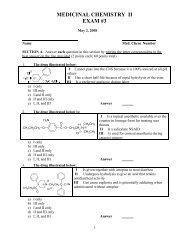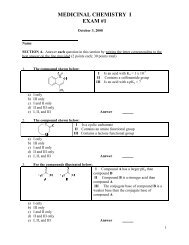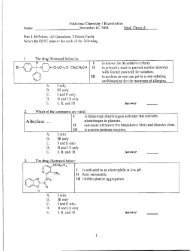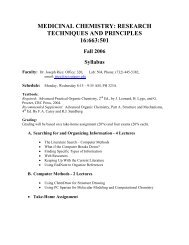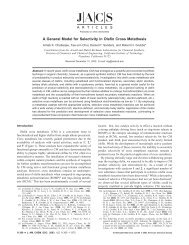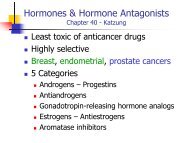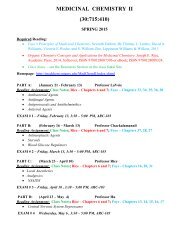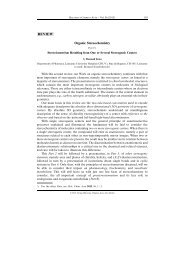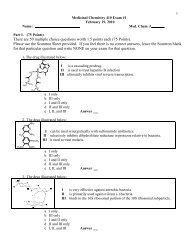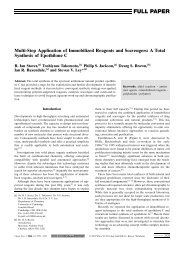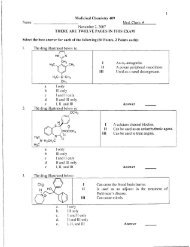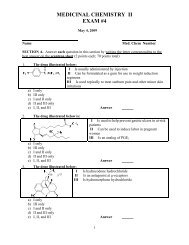Baldwin's Rules - Department of Medicinal Chemistry
Baldwin's Rules - Department of Medicinal Chemistry
Baldwin's Rules - Department of Medicinal Chemistry
Create successful ePaper yourself
Turn your PDF publications into a flip-book with our unique Google optimized e-Paper software.
Chemical Reviews REVIEW<br />
(O-allylendo3), Miranda and co-workers 183 found that the “anti-<br />
Michael” 5-(O-allylendo3)-exo-dig product is formed in 79% yield<br />
when using a protic solvent (EtOH). However, in acetone, the<br />
major product derives from the formal 6-(O-allylendo3)-endodig<br />
closure. These observations suggest that the 5-exo cyclization<br />
is kinetically favorable and gives the product as long as the<br />
cyclized carbanion is quickly and irreversibly trapped by protonation.<br />
In an aprotic solvent, the initially formed 5-exo-dig vinyl anion<br />
has enough time to rearrange to the more stable 6-endo-dig product,<br />
as has been suggested in similar systems (Scheme 55). 184,56 Tietze<br />
and co-workers have used this strategy for six-membered ring<br />
formation in their syntheses <strong>of</strong> several anthrapyran natural<br />
products. 185<br />
Scheme 55. Solvent-Dependent Cyclizations <strong>of</strong> Oxygen<br />
Anions with Three sp 2 -Atoms in the Linking Chain<br />
A formal 6-(O-allylendo2)-endo-dig cyclization has been<br />
reported by Padwa et al. (Scheme 56). 186 However, the authors<br />
do not exclude the initial formation <strong>of</strong> a 5-exo product which<br />
could rearrange in the six-membered benzopyran ring under<br />
workup conditions, similar to an analogous rearrangement<br />
reported by them for similar benzylic alcohols (vide infra,<br />
Scheme 57).<br />
Scheme 56. Formal O-6-(enolendo)-endo Cyclization<br />
Closure onto Aryl-Substituted Alkynes<br />
Cyclizations <strong>of</strong> other oxygen nucleophiles corresponding to<br />
motif A are also common. As expected based on the above calculations<br />
(Table 23), base-catalyzed cyclizations <strong>of</strong> aliphatic alcohols<br />
exclusively follow the 5-exo path, the vinyl anion serving as the base<br />
for another acyclic alcohol. When a secondary allylic alcohol 187 is<br />
used as opposed to a primary alcohol, 188 gem-dimethyl groups are<br />
required to facilitate the regioselective transformation. Trost and<br />
Runge found that reactions <strong>of</strong> secondary allylic alcohols with electron<br />
deficient alkynes were inefficient(


